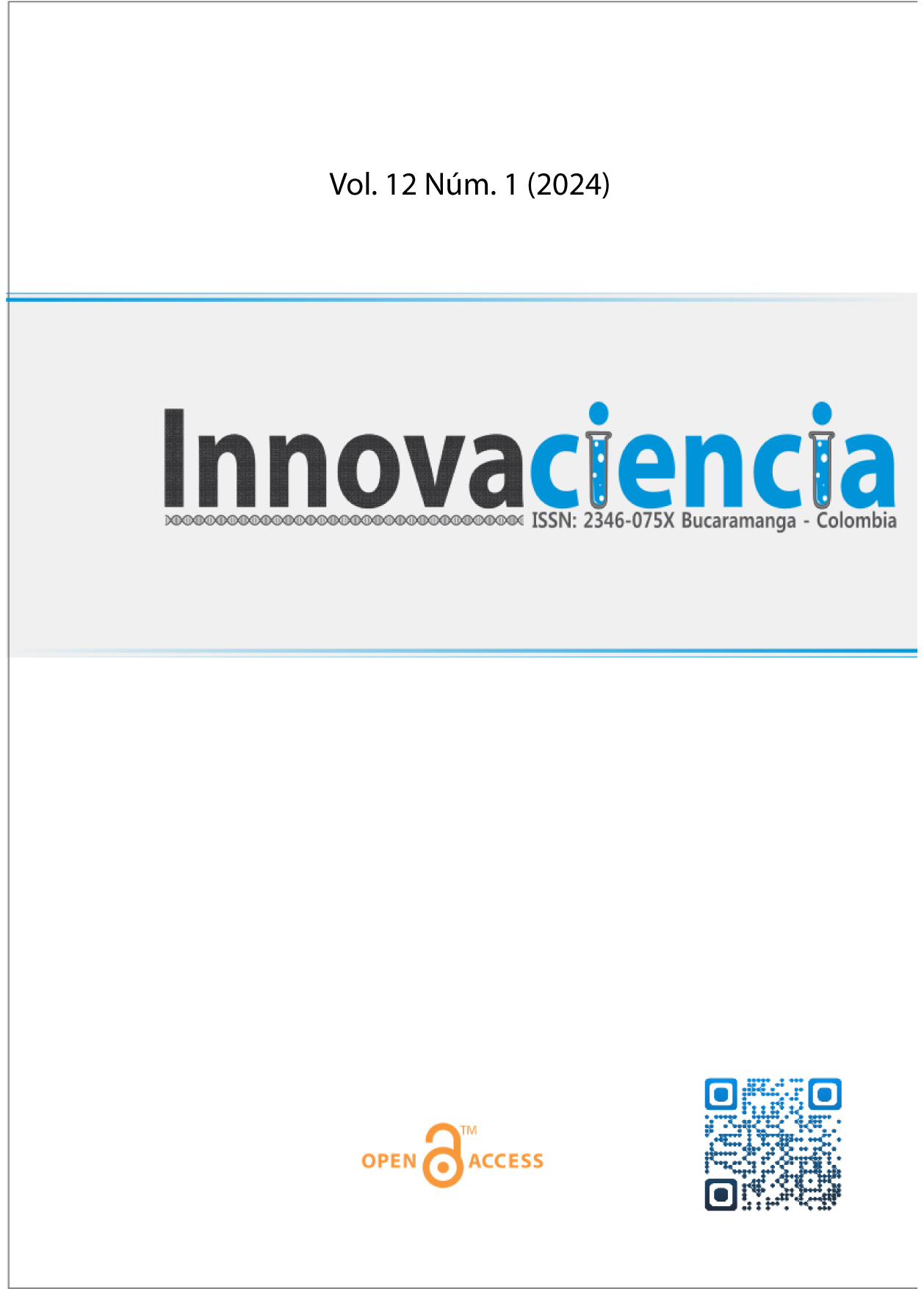Effect of two fertilizers on the growth of Vanilla planifolia Jacks. Ex-Andrews (Orchidaceae) during acclimatization.
DOI:
https://doi.org/10.15649/2346075X.4295Keywords:
Culture, in vitro, greenhouse, orchid, fertilizationAbstract
Introduction. Vanilla planifolia Jacks. ex Andrews, an endangered orchid native to Mexico, is cultivated worldwide for its valuable vanilla bean. Despite advances in in vitro propagation, optimizing cultivation protocols remains a challenge. Objective. This study evaluated the effects of two liquid and controlled-release fertilizer doses on the acclimatization of V. planifolia plantlets in a greenhouse. Materials and Methods.Plantlets from a germplasm bank were pre-acclimatized in perlite and then transferred to pots for acclimatization. Treatments included a liquid fertilizer (7-3-7.5 with naphthaleneacetic acid) at doses of 2.5 and 5 ml.L-1, and a controlled-release fertilizer (Plantacote® 6M 14-9-15+Mg+micros) at doses of 3 and 6 g/dm³ of substrate. Results and Discussion. Statistical analysis revealed significant differences between treatments and the control. However, fertilizers did not enhance plant growth parameters compared to the control. The 5 ml.L-1 liquid fertilizer showed the best performance among treatments. Conclusion. Results indicate that, under these conditions, the applied fertilizers, at recommended or doubled doses, did not provide additional benefits for the growth and development of V. planifolia.
References
Divakaran M, Babu KN, Peter KV. Conservation of Vanilla species, in vitro. Scientia horticulturae. 2006;110(2):175-180. https://doi.org/10.1016/j.scienta.2006.07.003
Lee-Espinosa HE, Murguía-González J, García-Rosas B, Córdova-Contreras AL, Laguna-Cerda A, Mijangos-Cortés JO, et al. In vitro clonal propagation of vanilla (Vanilla planifolia ‘Andrews’). HortScience. 2008;43(2):454-458. https://doi.org/10.21273/HORTSCI.43.2.454
Quintana MD, Herrera JVA. Desarrollo de cultivos sostenibles de vainilla en Ecuador. Revista de Investigación Talentos. 2020;7(1):71-79. https://doi.org/10.33789/talentos.7.1.123
Rodríguez-Deméneghi MV, Aguilar-Rivera N, Gheno-Heredia YA, Armas-Silva AA. Vanilla cultivation in Mexico: Typology, characteristics, production, agroindustrial prospective and biotechnological innovations as a sustainability strategy. Scientia Agropecuaria. 2023;14(1):93-109. https://doi.org/https://doi.org/10.17268/sci.agropecu.2023.009
Cardona CS, Marín-Montoya M, Díez MC. Identificación del agente causal de la pudrición basal del tallo de vainilla en cultivos bajo cobertizos en Colombia. Revista mexicana de micología. 2012;35:23-34. https://www.redalyc.org/pdf/883/88325120005.pdf
Vásquez AP, Bolaños BA, García JAG. Cultivo de la vainilla orgánica en sistemas agroforestales.Universidad En Diálogo: Revista de Extensión. 2013;3(1 y 2);31-46. https://www.revistas.una.ac.cr/index.php/dialogo/article/view/6434
Hernández-Ruíz J, Herrera-Cabrera BE, Delgado-Alvarado A, Salazar-Rojas VM, BustamanteGonzalez Á, Campos-Contreras JE, et al. Distribución potencial y características geográficas de poblaciones. Rev. Biol. Trop. 2016;64(1):235-246. https://doi.org/10.15517/rbt.v64i1.17854
Cisneros-Marrero IV, Miceli-Méndez CL, Rocha-Loredo AG, Peralta-Meixueiro MÁ, López-Miceli MA. Conservación in vitro a mediano plazo de vainilla (Vanilla planifolia Andrews; Orchidaceae). Polibotánica. 2024;(57):145-155. https://doi.org/10.18387/polibotanica.57.8
Gantait S, Kundu S. In vitro biotechnological approaches on Vanilla planifolia Andrews: advancements and opportunities. Acta Physiologiae Plantarum. 2017;39(9):196. https://doi.org/10.1007/s11738-017-2462-1
Baldí-Porras Y, Paniagua-Vásquez A, Azofeifa-Bolaños J, Mora-Salas J, Azofeifa-Bolaños M. Prueba de abonos foliares orgánicos en Vanilla planifolia producida in vitro durante las primeras etapas de crecimiento en invernadero. I Seminario Internacional de Vainilla. Promoviendo la investigación, extensión y producción de vainilla en Mesoamérica. 2013:167-176. https://www.researchgate.net/publication/343749004
Nuammee A, Pingyot T, Foowan S, Pumikong S, Rujichaipimon W, Sornpood S, et al. Effect of substrates of transplantation of the rare epiphytic orchid Dendrobium farmeri for conservation.Biodiversitas Journal of Biological Diversity. 2024;25(2): 708-715. https://doi.org/10.13057/biodiv/d250230
Hernández-Ramírez F, Dolce N, Flores-Castaños O, Rascón MP, Ángeles-Álvarez G, Folgado R, et al. Advances in cryopreservation of vanilla (Vanilla planifolia Jacks.) shoot-tips: assessment of new biotechnological and cryogenic factors. In Vitro Cellular & evelopmental Biology-Plant. 2020;56: 236-246. https://doi.org/10.1007/s11627-020-10069-w8
Santillán-Fernández A, Trejo-Cabrera M, Martínez-Sánchez A, Martínez ÁL, Vásquez-Bautista N, Mejía SL. Production potential of Vanilla planifolia Jacks in Totonacapan, Mexico, using geographic techniques. Revista mexicana de ciencias agrícolas. 2019;10(4), 789-802. https://doi.org/10.29312/remexca.v10i4.1661
Murashige T, Skoog F. A revised medium for rapid growth and bioassays whith tobacco tissue cultures. Copenhagen. Physiologia Plantarum. 1962;15: 473-497. https://doi.org/10.1111/j.1399-3054.1962.tb08052.x
Di Rienzo JA, Casanoves F, Balzarini MG, González L, Tablada M, Robledo CW. InfoStat, versión 2020, Grupo InfoStat, FCA, Universidad Nacional de Córdoba, Argentina. https://www.infostat.com.ar/
Méndez JLM, Villa AC, Ávila VMC. Estrategia de desarrollo regional sustentable en el cultivo in vitro de vainilla (vanilla planifolia) in vitro. Universidad & ciencia. 2021;10: 89-104. https://revistas.unica.cu/index.php/uciencia/article/view/2018
Hernández-Leal E, Castillo-Martínez CR, Reyes-López D, Corona-Torres T, Avendaño-Arrazate CH, García-Zavala OJJ, et al. Aclimatacion de hibridos intraespecificos de Vanilla planifolia Jacks. ex Andrews, obtenidos in vitro. AGROProductividad. 2016;9(11):72-78. https://revista-agroproductividad.org/index.php/agroproductividad/article/view/848
Osorio AI, Vega NW, O, Díez MC, Moreno FH. Nutrient status and vegetative growth of Vanilla planifolia Jacks plants as affected by fertilization and organic substrate composition. Acta Agronómica. 2014;63(4):326-334. https://doi.org/10.15446/acag.v63n4.40754
Azofeifa-Bolaños JB, Rivera-Coto G, Paniagua-Vásquez A, Cordero-Solórzano, R. Respuestas morfogenéticas de plantas in vitro y esquejes de Vanilla planifolia (Orchidaceae) durante el desarrollo inicial del cultivo en invernadero y en sistemas agroforestales. Cuadernos de Investigación UNED. 2018a;10(2):368-378. http://dx.doi.org/10.22458/urj.v10i2.1995
de Lima, J.F., de Oliveira, D.C., Kuster, V.C. et al. Aerial and terrestrial root habits influence the composition of the cell walls of Vanilla phaeantha (Orchidaceae). Protoplasma (2024). https://doi.org/10.1007/s00709-024-01980-9.
Mahadeo, K., Taïbi, A., Meile, JC. et al. Exploring endophytic bacteria communities of Vanilla planifolia. BMC Microbiol 24, 218 (2024). https://doi.org/10.1186/s12866-024-03362-w22.
Azofeifa-Bolaños JB, Rivera-Coto G, Paniagua-Vasquez A, Cordero-Solórzano R. Selección cualitativa del esqueje en la sobreviviencia y desarrollo morfogenético de Vanilla planifolia Andrews. Agronomía Mesoamericana. 2018b;29: 619–627. https://doi.org/10.15517/ma.v29i3.32213
Martínez-Monter JP, García-López E, Castillo-Martínez A, Romero-Santos RD, Fajardo-Franco ML, Palemón-Alberto F. Sustratos orgánicos en el desarrollo de raíces en esquejes de vainilla (Vanilla planifolia Jacks. ex Andrews). Acta Agrícola y Pecuaria. 2022;8(1): 1-9. https://doi.org/10.30973/aap/2022.8.008101
Downloads
Additional Files
Published
How to Cite
Issue
Section
Altmetrics
Downloads
License
Copyright (c) 2024 Innovaciencia

This work is licensed under a Creative Commons Attribution-NonCommercial 4.0 International License.
All articles published in this scientific journal are protected by copyright. The authors retain copyright and grant the journal the right of first publication, with the work simultaneously licensed under a Creative Commons Attribution-NonCommercial 4.0 International License (CC BY-NC 4.0), which permits sharing the work with authorship recognition and without commercial purposes.
Readers may copy and distribute the material from this journal issue for non-commercial purposes in any medium, provided the original work is cited and credit is given to the authors and the journal.
Any commercial use of the material from this journal is strictly prohibited without written permission from the copyright holder.
For more information on the copyright of the journal and open access policies, please visit our website.




















